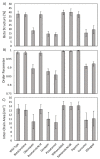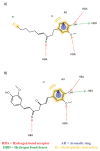The Impact of Natural Compounds on S-Shaped Aβ42 Fibril: From Molecular Docking to Biophysical Characterization
- PMID: 32188076
- PMCID: PMC7139307
- DOI: 10.3390/ijms21062017
The Impact of Natural Compounds on S-Shaped Aβ42 Fibril: From Molecular Docking to Biophysical Characterization
Abstract
The pursuit for effective strategies inhibiting the amyloidogenic process in neurodegenerative disorders, such as Alzheimer's disease (AD), remains one of the main unsolved issues, and only a few drugs have demonstrated to delay the degeneration of the cognitive system. Moreover, most therapies induce severe side effects and are not effective at all stages of the illness. The need to find novel and reliable drugs appears therefore of primary importance. In this context, natural compounds have shown interesting beneficial effects on the onset and progression of neurodegenerative diseases, exhibiting a great inhibitory activity on the formation of amyloid aggregates and proving to be effective in many preclinical and clinical studies. However, their inhibitory mechanism is still unclear. In this work, ensemble docking and molecular dynamics simulations on S-shaped Aβ42 fibrils have been carried out to evaluate the influence of several natural compounds on amyloid conformational behaviour. A deep understanding of the interaction mechanisms between natural compounds and Aβ aggregates may play a key role to pave the way for design, discovery and optimization strategies toward an efficient destabilization of toxic amyloid assemblies.
Keywords: Alzheimer’s disease; Amyloid β; S-shape; ensemble docking; molecular dynamics; natural compounds.
Conflict of interest statement
The authors declare no conflict of interest.
Figures





Similar articles
-
Understanding amyloid fibril nucleation and aβ oligomer/drug interactions from computer simulations.Acc Chem Res. 2014 Feb 18;47(2):603-11. doi: 10.1021/ar4002075. Epub 2013 Dec 24. Acc Chem Res. 2014. PMID: 24368046 Review.
-
Biophysical Properties of the Fibril Structure of the Toxic Conformer of Amyloid-β42: Characterization by Atomic Force Microscopy in Liquid and Molecular Docking.ACS Appl Mater Interfaces. 2023 Jun 14;15(23):27789-27800. doi: 10.1021/acsami.3c06460. Epub 2023 Jun 1. ACS Appl Mater Interfaces. 2023. PMID: 37261999
-
N-Terminus Binding Preference for Either Tanshinone or Analogue in Both Inhibition of Amyloid Aggregation and Disaggregation of Preformed Amyloid Fibrils-Toward Introducing a Kind of Novel Anti-Alzheimer Compounds.ACS Chem Neurosci. 2017 Jul 19;8(7):1577-1588. doi: 10.1021/acschemneuro.7b00080. Epub 2017 Apr 28. ACS Chem Neurosci. 2017. PMID: 28406293
-
The Anti-Amyloidogenic Action of Doxycycline: A Molecular Dynamics Study on the Interaction with Aβ42.Int J Mol Sci. 2019 Sep 19;20(18):4641. doi: 10.3390/ijms20184641. Int J Mol Sci. 2019. PMID: 31546787 Free PMC article.
-
Elucidating the Structures of Amyloid Oligomers with Macrocyclic β-Hairpin Peptides: Insights into Alzheimer's Disease and Other Amyloid Diseases.Acc Chem Res. 2018 Mar 20;51(3):706-718. doi: 10.1021/acs.accounts.7b00554. Epub 2018 Mar 6. Acc Chem Res. 2018. PMID: 29508987 Free PMC article. Review.
Cited by
-
Toward the design and development of peptidomimetic inhibitors of the Ataxin-1 aggregation pathway.Biophys J. 2022 Dec 6;121(23):4679-4688. doi: 10.1016/j.bpj.2022.10.021. Epub 2022 Oct 19. Biophys J. 2022. PMID: 36262042 Free PMC article.
-
In silico investigation of Alsin RLD conformational dynamics and phosphoinositides binding mechanism.PLoS One. 2022 Jul 18;17(7):e0270955. doi: 10.1371/journal.pone.0270955. eCollection 2022. PLoS One. 2022. PMID: 35849605 Free PMC article.
-
Natural Inhibitors of Amyloid Aggregation.Int J Mol Sci. 2023 Aug 28;24(17):13310. doi: 10.3390/ijms241713310. Int J Mol Sci. 2023. PMID: 37686116 Free PMC article.
-
Natural Compounds as Inhibitors of Aβ Peptide Aggregation: Chemical Requirements and Molecular Mechanisms.Front Neurosci. 2020 Dec 22;14:619667. doi: 10.3389/fnins.2020.619667. eCollection 2020. Front Neurosci. 2020. PMID: 33414705 Free PMC article. Review.
References
-
- Cohen S.I.A., Linse S., Luheshi L.M., Hellstrand E., White D.A., Rajah L., Otzen D.E., Vendruscolo M., Dobson C.M., Knowles T.P.J. Proliferation of amyloid- 42 aggregates occurs through a secondary nucleation mechanism. Proc. Natl. Acad. Sci. USA. 2013;110:9758–9763. doi: 10.1073/pnas.1218402110. - DOI - PMC - PubMed
MeSH terms
Substances
LinkOut - more resources
Full Text Sources

